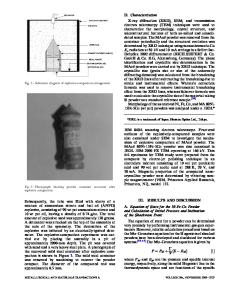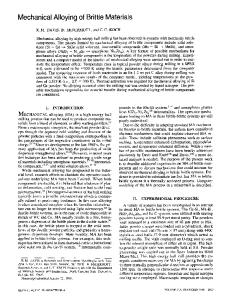Low-Temperature Mechanical Alloying Of Cu-Fe and Cu-Ta Powders
- PDF / 493,032 Bytes
- 6 Pages / 414.72 x 648 pts Page_size
- 20 Downloads / 321 Views
where rb is the atomic jump frequency caused by external forcing (termed "ballistic" effects in the case of irradiation) which drives alloying or disordering, and "t is the atomic jump frequency due to thermal diffusion which favors phase separation or ordering. However, it should be pointed out that the thermodynamic driving forces for diffusional phase separation and atomic movements are also altered in a milled mixture. In the following, we analyze solubility extension using a model incorporating both thermodynamic and dynamic effects. For a regular solution in thermodynamic equilibrium, the chemical potential of element B, MB, in an A-B solution (a) is given by [4] (2) EB = GB + 9(1- xB)2 + RTlnxB where GB is the molar free energy of pure B with the a structure, £2 the enthalpy of solution, xB the mole fraction of B, T the temperature, and R the gas constant. The equilibrium solubility (B in A, e.g., Cu in Fe), eq, is given by x
exp{- AGB + 0(1-xB
(3)
RT
where AGB is the difference in free energy between pure B in the 03form and the a form. When eq is small, it is essentially exponentially dependent on the energy term AGB+92. For systems such as Cu-Fe and Cu-Ta, this positive energy term dictates a vanishingly small equilibrium solubility at the milling temperature (-350 K). 637
Mat. Res. Soc. Symp. Proc. Vol. 481 01998 Materials Research Society
Therefore, the alloying observed (e.g. between Cu and Fe) has to be entirely due to the dramatic effects of ball milling. It is expected that for milling-generated embedded small particles with radius r and surface energy y, solubility will be enhanced through the term 2Y'r. In addition, the large stresses (a), either repeatedly applied externally due to ball impact or associated with milling-induced dislocations, further enhances solubility with a maximum effect of (GVm. Using these excess terms to modify the chemical potential, Eq. 3 becomes xBxp{
'(1 -- xeq)2 + AGBERVm-GVm RT
where Vm is the molar volume. Using representative values such as r=6nm, o--1 GPa and y= 1 Jim 2 , Eq. 3 predicts a solubility of less than 0.1 at% at 350 K. In other words, although the milling-induced interface and stress effects may enhance solubility by a large factor, they are insufficient to extend the vanishingly small solubility to the level observed. As pointed out above, however, we are dealing with a dynamic, externally driven system in which a balance between two atomic fluxes should be considered, as shown by Martin [3] j = jth + jB = -MNI[f of+ --B-l-dc - 2 ic dcx3} (5) Tx 3 ) M dx One flux, jth, derives from thermally activated movements mediated by a milling-enhanced population of defects under the thermodynamic driving forces present. Acting in parallel are the athermal atomic exchanges associated with the nonequilibrium deformation action, which forces "ballistic" mixing. One example is the shearing of atomic planes. An atomic flux, jB, is generated during this or other athermal processes, leading to mixing in addition to the formation of various types of extended def
Data Loading...











